I’m Booooooooooooooooooooooooored
I left a PSA (Police Service Area) community meeting early because I figured playing Civ (my addiction) would be far more interesting than hearing crime stats, listening to the same complaints and what not.
This month’s meeting talked about the switch over to the 5th District and leaving the 3rd District. That should have been interesting on it’s own, but no. The crime stats were slightly interesting. I mean I learned something new, our PSA had about 900 calls for service in the past month. Some were repeat calls.
As at every meeting, well not every, there is the one angry person. Past angry people are citizens who just heard about the meeting and come to vent about the drug dealing, the loitering, (sometimes) prostitution, abandoned cars, abandoned properties or (my fav) the crime that happened to them. Not to dump on crime victims, but just ’cause YOU finally became a victim does not mean the world suddenly jumps into action. It is sad that it takes a crime for you to finally get involved in your community. But they don’t stay invovled, they just vent and leave, never to be seen again. Tonight’s angry citizen was an angry black man who thought this give and take between the citizens and police was odd, and mentioned this several times. It was new and foreign because, as he explained, his past dealings with police have been confrontational. He finally said what brought him to the meeting, apparently he’s the manager of a residence and the warrent squad and he got into it at 6AM.
Civ was more interesting.
